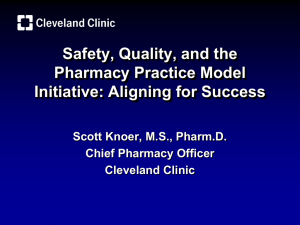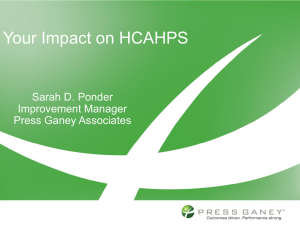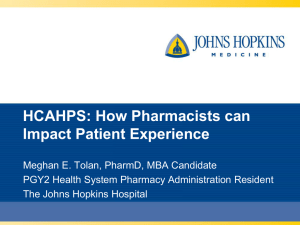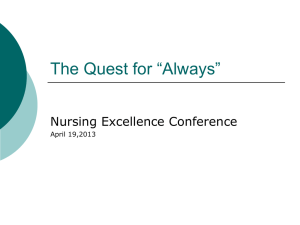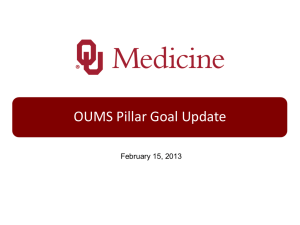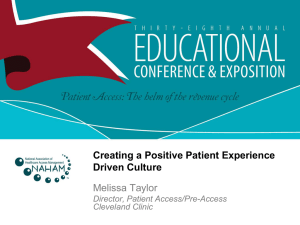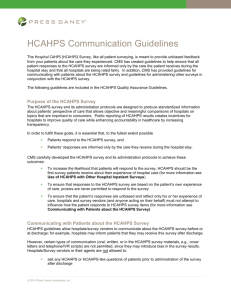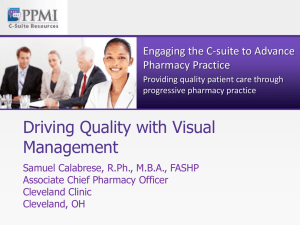Resource - Indiana Rural Health Association
advertisement
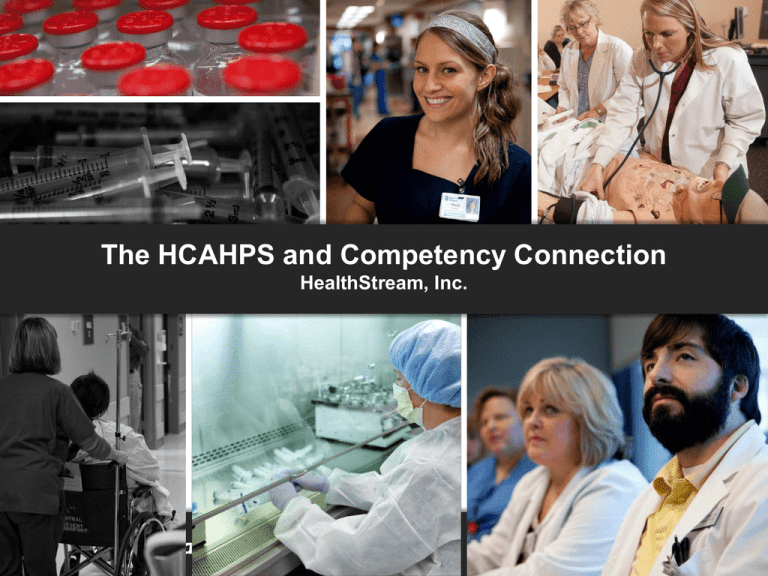
The HCAHPS and Competency Connection HealthStream, Inc. OBJECTIVES: • Understand the HCAHPS initiative and VBP • Identify key components of HCAHPS that are linked to competency • Explore the impact of competencies on HCAHPS performance • Discover how to select appropriate competencies • Learn how to standardize competency selection process • Uncover ways to promote employee accountability HealthStream’s VISION To improve the quality of healthcare by assessing and developing the people that deliver care. Insights Online HCAHPS Impact Report Learning Platform Measurement Learning Insight Action through through Research Learning VBP Report Card Improved Performance Call Center Improvement Courseware Understanding the HCAHPS Initiative and Value Based Purchasing What is CAHPS? Consumer Assessment of Healthcare Providers and Systems H-CAHPS: Hospital Inpatients HH-CAHPS: Home Health Patients CG-CAHPS: Physician Clinic & Group Office Patients ICH-CAHPS: In-Center Hemodialysis Patients LTC-CAHPS: Nursing home residents and family members • More to come! • • • • • Differences in Survey Question Scales Overall, how would you rate the care you received? Very Good 53% Good Fair Poor 22% 14% 9% Very Poor 2% During this hospital stay, how often did nurses explain things in a way you could understand? Always Usually Sometimes Never 40% 25% 25% 5% The H-CAHPS Survey • Six Domains • Communication with nurses • Communication with doctors • Responsiveness of hospital staff • Pain management • Communication about medicines • Discharge information • Two Individual Questions • Cleanliness of hospital • Quietness of hospital • Two Overall Questions • Overall hospital rating (0 – 10 point scale) • Would recommend (4 point scale-definitely yes) HCAHPS USES FREQUENCY SCALE: Always Usually Sometimes Never Data Adjustments CMS will take the data collected and adjust for… • MODE: type of methodology used (phone vs. mail vs. mixed) • PATIENT MIX: Service line, age, education, health status, language spoken in home, time since discharge, etc. Public Reporting of H-CAHPS Results How often did nurses communicate well with patients? www.hospitalcompare.hhs.gov Patient Protection and Affordable Care Act VBP: Value Based Purchasing Program • Enacted March 23, 2010 • Repealed January 19, 2011 • A specified percentage (1-2%) of hospital payments will be conditional on performance • Critical Access Hospitals were not previously required to participate in HCAHPS Value Based Purchasing (VBP) • CMS released VBP details January 7, 2011 • A percentage of a hospital’s base DRG rate is impacted • • • • • Reimbursement FY2013: Reimbursement FY2014: Reimbursement FY2015: Reimbursement FY2016: Reimbursement FY2017+: 1.00% of payments 1.25% of payments 1.50% of payments 1.75% of payments 2.00% of payments 70% of reimbursement based on 15 clinical and outcome measures 30% on HCAHPS survey results MBQIP Medicare Beneficiary Quality Improvement Project • Office of Rural Health Policy (ORHP): “This initiative takes a proactive approach to ensure CAH’s are well prepared to meet future quality requirements.” • September 2012 – Phase II Began – included HCAHPS • “Voluntary” Identifying Key Components of HCAHPS Linked to Competency The H-CAHPS Survey • Six Domains • Communication with nurses • Communication with doctors • Responsiveness of hospital staff • Pain management • Communication about medicines • Discharge information • Two Individual Questions • Cleanliness of hospital • Quietness of hospital • Two Overall Questions • Overall hospital rating (0 – 10 point scale) • Would recommend (4 point scale-definitely yes) HCAHPS USES FREQUENCY SCALE: Always Usually Sometimes Never Hospitals Nationally Are Achieving High Scores Top Box Results from the CMS National Database (2nd Quarter 2011 Release) Discharge Information 81% Willingness to Recommend 68% Doctor Communication 80% Overall Rating of Hospital 66% Nurse Communication 75% Responsiveness of Staff 63% Cleanliness of Room / Bathroom 70% Communication about Medicines 59% Pain Management 69% Quietness 57% HCAHPS Overall Performance Date Jul `07 - Oct `07 - Jan `08 - Apr `08 - Jul `08 - Oct `08 - Jan `09 - Apr `10 Jun `08 Sep `08 Dec `08 Mar `09 Jun `09 Sep `09 Dec `09 Mar `11 Change over 2 years Hospital Count 3,711 3,746 3,765 3,766 3,775 3,773 3,792 3,798 Nurse Communication 74% 74% 74% 74% 75% 75% 75% 76% 2% Doctor Communication 80% 80% 80% 80% 80% 80% 80% 80% -- Responsiveness of Hospital Staff 62% 62% 62% 62% 63% 63% 63% 64% 2% Pain Management 68% 68% 68% 68% 68% 69% 69% 69% 1% Communication About Medicines 59% 59% 59% 59% 59% 59% 60% 60% 1% Cleanliness of Room/Bathroom Quietness of Area Around Room at Night 69% 69% 69% 70% 70% 70% 70% 71% 2% 56% 56% 56% 56% 57% 57% 57% 58% 2% Discharge Information 80% 80% 80% 80% 81% 81% 81% 81% 1% Overall Rating of Hospital Willingness to Recommend Hospital 64% 64% 64% 65% 65% 66% 66% 67% 3% 68% 68% 68% 68% 68% 68% 69% 69% 1% HCAHPS Composite 68% 68% 68% 68% 69% 69% 69% 70% 2% Exploring the Impact of Competency on HCAHPS Linking Employee and Physician Satisfaction and Competency to HCAHPS Results Results of a Recent Multivariate Study: Employee and Physician Predictors of HCAHPS Scores: What factors/variables predict HCAHPS scores? Methodology Sample: The sample included 237 HealthStream client hospitals. Data used were employee satisfaction scores, physician satisfaction scores and HCAHPS inpatient scores. Total Beds and Average Length of Stay were obtained from an external data source. Methodology • A multiple regression analysis was conducted on the data. • • • • • • • • • Independent (predictor) Variables: Employee Ratings of Administration Employee Ratings of Immediate Supervisor Employee Satisfaction/Loyalty Physician Ratings of Administration Physician Ratings of Hospital Efficiency Physician Ratings of Nursing Skill Total Beds ALOS • • Dependent Variable: HCAHPS Overall Hospital Score Summary of HCAHPS Predictors Three variables significantly predicted HCAHPS scores: Standardized Beta Significance Employee Satisfaction & Intent to Stay .78 p<.001 Employee Perceptions of Upper Management -.46 p<.001 Physician Perceptions of Nursing Skill .27 p<.001 Significant Predictors Implications • Employee satisfaction/loyalty and HCAHPS scores • Employee satisfaction is critical to inpatient care • Physician rating of nursing skill and HCAHPS scores • Importance of physicians’ perceptions of nursing skill • Employee ratings of administration and HCAHPS scores • This unexpected finding can help administrators understand potential low employee administration ratings in the quest toward HCAHPS improvement efforts Questions? Kylie B. Taylor Regional Director (443) 744-0299 kylie.taylor@healthstream.com
